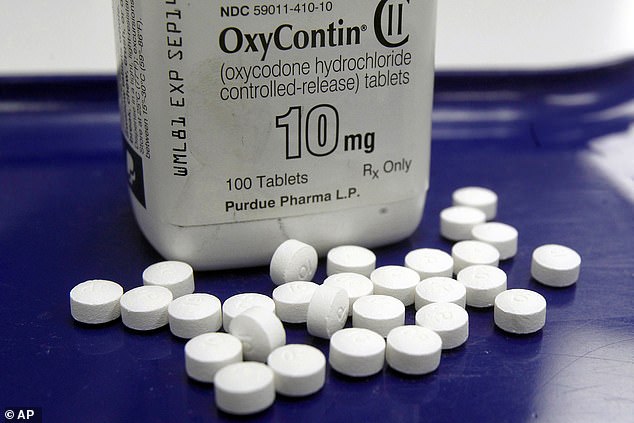Doctors are A THIRD more likely to prescribe opioids later in the day, study finds
- Physician fatigue and schedule may effect their decision-making
- Opioid over-prescribing is blamed in part for the current US opioid epidemic
- University of Minnesota researchers found that 4% of patients with early appointments get opioid prescriptions
- By the end of the day, 5.3% of patients get prescriptions for the addictive drugs
- Opioid prescriptions were more common the later an appointment was running
US patients who have appointments later in the day are more likely to be prescribed opioid painkillers, a new study suggests.
The beginning of the American opioid epidemic is blamed largely on the over-prescription of addictive painkillers.
Health officials have urged doctors to use their utmost discretion in prescribing opioids – but concerns remain that factors beyond the patient’s needs may contribute to physicians’ decisions.
University of Minnesota researchers found that as the day wears on, fatigued doctors are more than 33 percent more likely to prescribe addictive painkillers.

A third more patients seen at the end of a day are prescribed addictive painkillers like OxyContin (pictured, file) than those who see their primary care doctors first thing, study finds
OxyContin was a revolution for pain management when its use became widespread in the US in the 1990s.
It quickly became a best-selling painkiller by 2001, and has made its seller, Purdue Pharma, over $ 35 billion.
The potent drug worked, patients liked it, so doctors kept prescribing it.
Prescription rates soared and by 2017, enough opioid prescriptions had been handed out in 16 percent of US counties that every person living in each could have one.
And that was a decline from the 2006 peak of opioid prescribing, when 255 million prescriptions were written.
For a disturbing number of patients or their family members who received the prescriptions, the drugs meant to bring relief were the start of a painful – and, in some cases, deadly – addiction.
Researchers estimate that as much as 80 percent of people addicted to heroin were first exposed to opioids through prescription drugs that they either received from a doctor or from someone who had been prescribed more pills than they needed.
So reducing prescriptions for opioid painkillers has become a primary public health initiative in the US.
Prescription rates reached their lowest in over a decade in 2017 – but too many are still being prescribed.
Understanding the factors that drive doctors to over-prescribe opioids is key to stemming the flow of the drugs to the community.
Pain is a common patient complaint and prescription painkillers a quick solution – a fact which some may take advantage of in order to get drugs for misuse.
Nearly a quarter of doctors work between 60 and 80 hours a week, seeing an average of 19 patients a day.
Physician fatigue is a considerable risk factor for medical mistakes and misjudgments.
So researchers at the University of Minnesota might have any bearing on the odds that – appropriately or otherwise – doctors prescribe opioids.
And according to their new study, published in JAMA Open Network, that might well be the case.
After analyzing records from 678,319 primary care patients seen by 5,603 doctors, they found a significant difference in prescription rates based on timing.
On any given day, an average of four percent of patients in the first three appointment slots were prescribed opioids.
By the afternoon, when doctors were on their 19th, 20th or even 21st appointment of the day, 5.3 percent of patients were sent home with prescriptions for the drugs.
Those rates are low in absolute terms, but it’s a difference of a full third in the odds someone gets addictive drugs.
And the more behind schedule an appointment was, the more liberal doctors were with their prescription pads.
if an appointment was running nine minutes or less late, 4.4 percent of patients got opioid prescriptions.
If the delay stretched to over an hour, 5.2 percent received opioid prescriptions.
‘Avoiding opioid prescribing risks disappointing patients and making visits longer, because time is needed to explain nonopioid alternatives for pain management,’ wrote the study authors.
‘However, defaulting to an opioid prescription has clinical ramifications because even short, self-limited prescriptions of opioids can play a substantial role in patients transitioning to long-term opioid use.’
Their findings are a humbling reminder of the effect pressures faced by even a single doctor can have on public health amid an addiction epidemic in the US.
‘Full-time clinicians may have higher opioid prescribing rates simply because of the effort involved in long clinical days,’ the study authors wrote.
‘Sharing individual data on these patterns with physicians could raise awareness of this bias and help them develop approaches such as schedule modifications to lower the burden of taxing or time-consuming decisions late in the day.’
